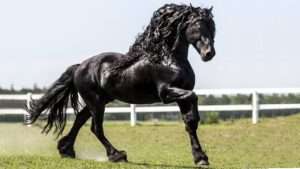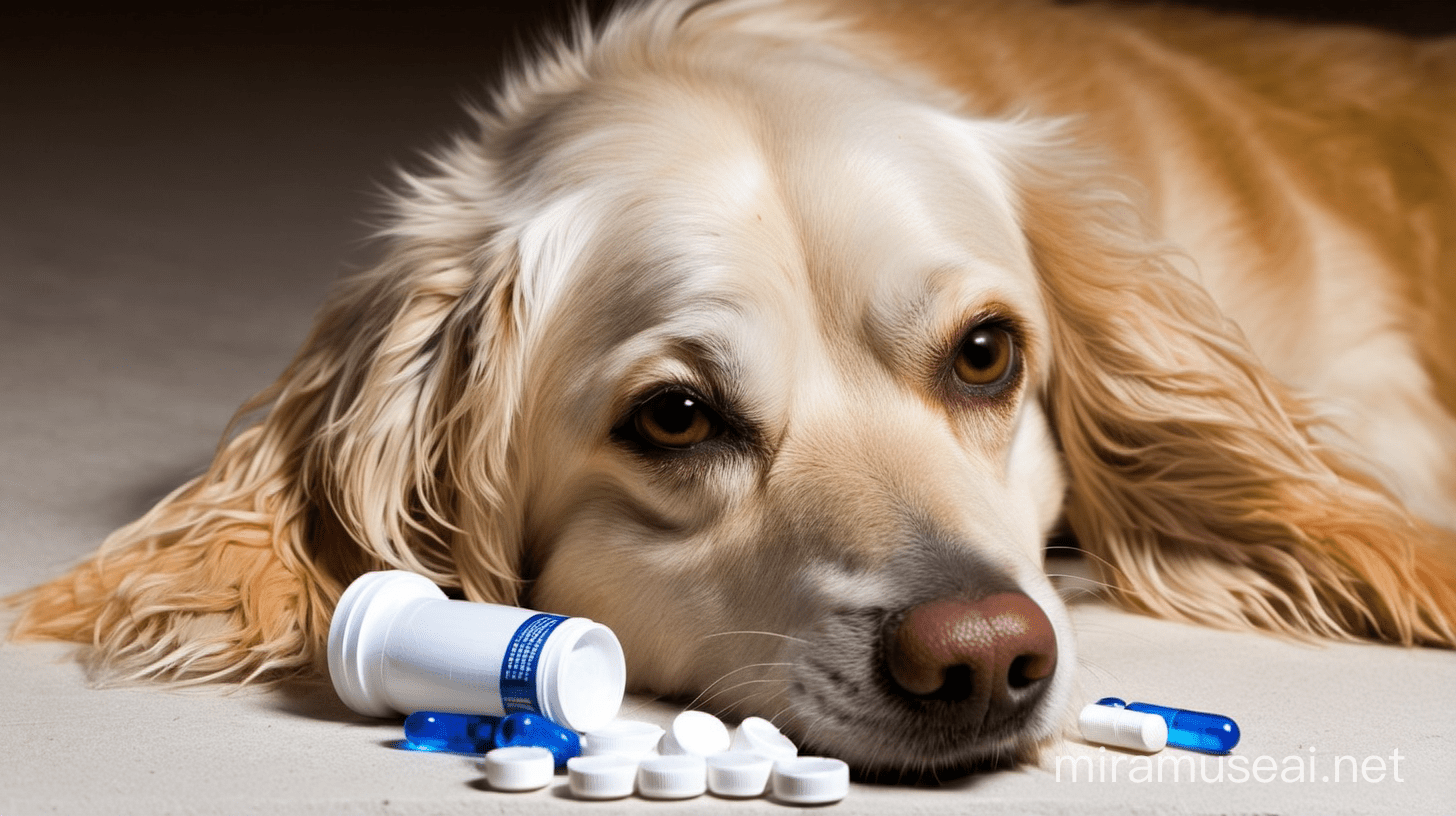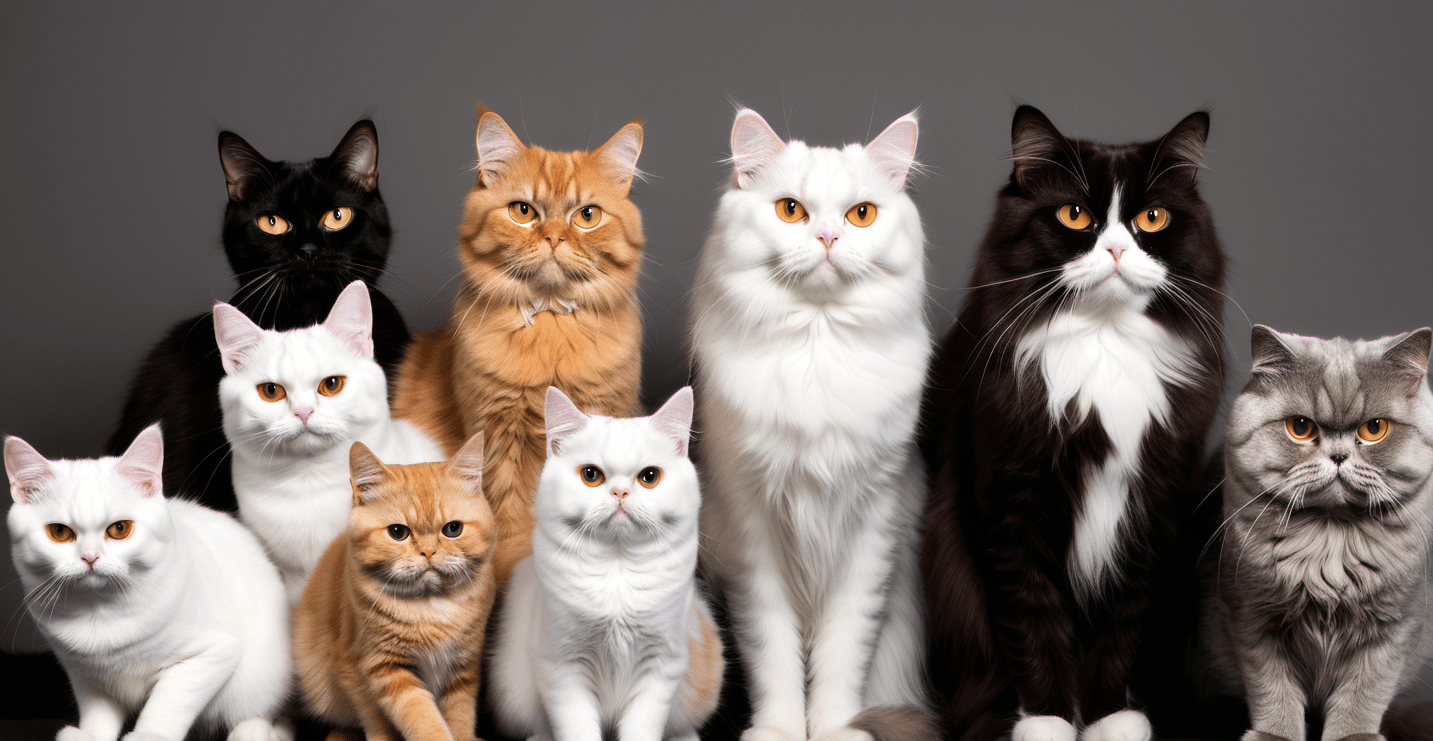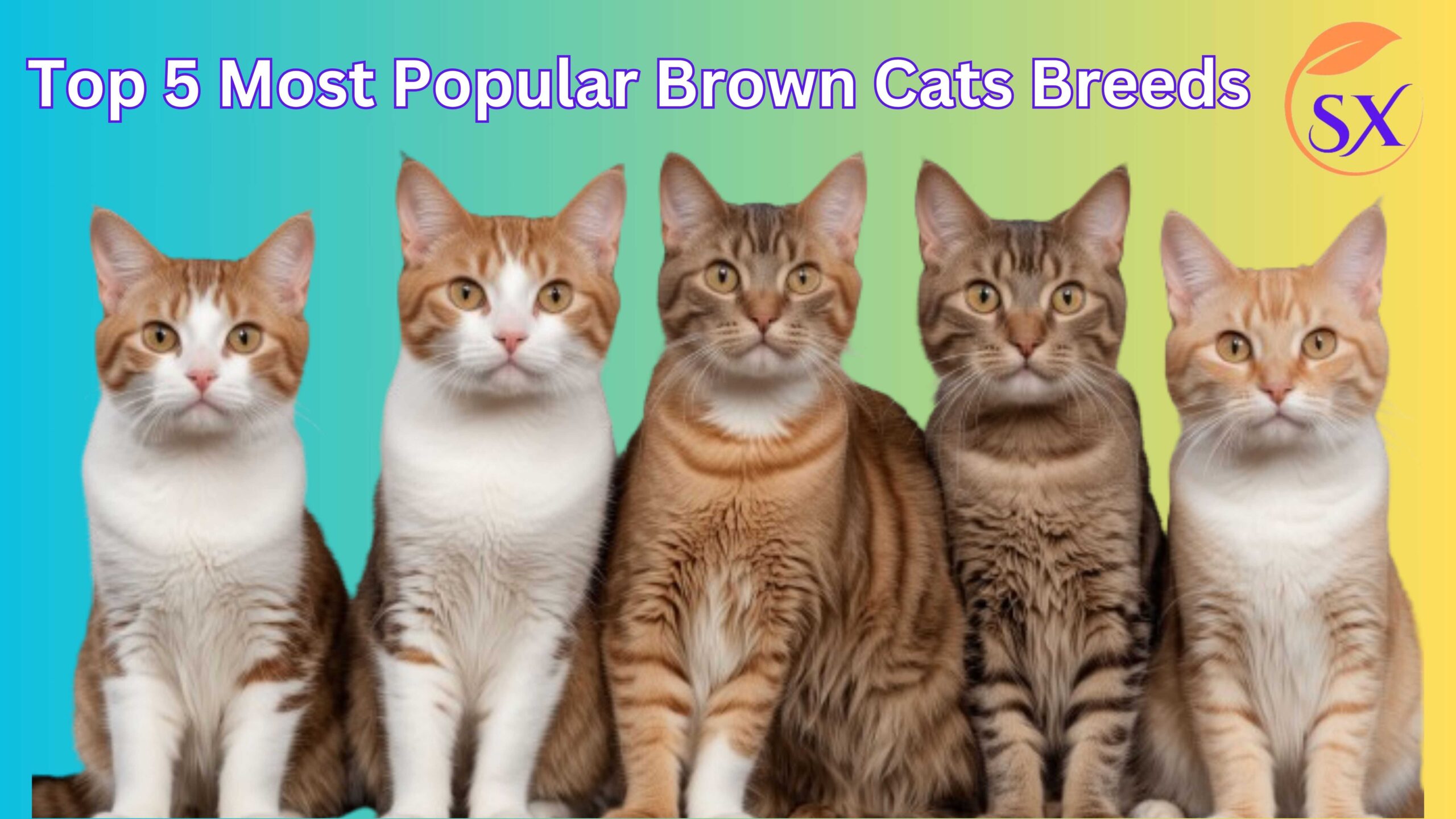Friesian horses, originating from the Netherlands, are renowned for their striking appearance characterized by a glossy black coat, flowing mane and tail, and feathering on their lower legs. Their noble stature and elegant movement make them a favorite among equestrians and admirers worldwide.
Friesian horses are easily recognizable by their powerful build, arched necks, and expressive eyes. They typically stand between 15 to 17 hands high, embodying strength and grace in equal measure. Their distinctive trot, known as the “floating trot,” showcases their athleticism and fluid movement, making them ideal for various disciplines, including dressage and driving.
This section describes the history, characteristics, health issues, and nutritional requirements of the Friesian breed. Read on to learn more about feeding and caring for Friesians.

History Of Friesian Horse
During the Middle Ages, Friesian horses were highly esteemed and sought after by European nobility. They were often favored as mounts for knights due to their strength, agility, and noble bearing. Additionally, they were frequently used to pull carriages and plows, contributing to the agricultural prosperity of the region.
Origins and Development of Friesian Horse
The roots of the Mustang dark horse trace back centuries, to the fertile lands of Friesland in the Netherlands. Renowned for its lush pastures and agricultural prowess, Friesland provided an ideal environment for the breeding and development of these magnificent equines. Bold and sturdy, Friesian horses were prized for their strength and versatility, serving as trusted companions for farmers and knights alike.
The Middle Ages: From Warhorse to Workhorse Friesian Horse
During the Middle Ages, Friesian horses emerged as valuable assets on the battlefield. Renowned for their powerful build and fearless demeanor, these noble steeds carried knights into the fray with unwavering courage. Yet, beyond the chaos of combat, Friesian horses also proved indispensable in everyday life, assisting farmers in plowing fields and transporting goods across vast distances.
Renaissance and Resurgence
As Europe transitioned into the Renaissance era, Friesian horses experienced a resurgence in popularity. Nobility and aristocracy coveted these elegant equines for their grace and beauty, often showcasing them in grand processions and equestrian events. The Friesian horse’s distinctive appearance, characterized by its flowing mane, feathered legs, and ebony coat, captivated audiences and earned it a place of honor among the continent’s elite.
Threats and Preservation Efforts
Despite their esteemed status, Friesian horses faced numerous threats to their existence over the centuries. Wars, disease outbreaks, and shifting cultural preferences jeopardized the breed’s survival, prompting dedicated enthusiasts to rally behind conservation efforts. Through meticulous breeding programs and advocacy campaigns, these guardians of Friesian heritage ensured that future generations would continue to marvel at the breed’s magnificence.
Modern-Day Friesian Horses
In the modern era, Friesian horses enjoy widespread admiration and acclaim as symbols of elegance and grace. From their starring roles in film and television to their appearances in prestigious dressage competitions, Friesians enchant audiences with their poise and charisma. Moreover, their gentle disposition and willingness to form deep bonds with humans have endeared them to equestrians of all ages and backgrounds.
Friesian Horse Breed Registry
Preservation of Pedigree
Central to the Friesian horse’s legacy is the Friesian Horse Breed Registry, an institution committed to upholding breed standards, maintaining accurate pedigrees, and promoting responsible breeding practices. Founded on principles of authenticity and excellence, the registry serves as a guardian of the breed’s integrity and genetic diversity.
Registration Process
Prospective Friesian owners embark on a journey of registration and certification with the registry, ensuring that each horse meets stringent criteria for inclusion. From verifying parentage to assessing conformation and temperament, the registration process upholds the breed’s esteemed reputation while providing owners with invaluable documentation and support.

Breed Characteristics
The Friesian horse breed is renowned for its distinctive appearance and remarkable characteristics. Here are some key traits:
Appearance
Friesian horses are known for their striking black coat color, although occasionally they may be chestnut. They have a long, flowing mane and tail, with feathering on the lower legs.
Build
Friesians typically have a powerful, muscular build with a high-set, arched neck, and a well-defined, broad chest. They have strong, sturdy legs which contribute to their graceful movement.
Height and Weight
Friesians are typically tall horses, standing between 15.3 to 17 hands high (approximately 155 to 175 centimeters). They can weigh anywhere from 1200 to 1400 pounds (approximately 550 to 635 kilograms).
Temperament
Friesians are known for their gentle and friendly nature. They are often described as being willing, intelligent, and eager to please, making them suitable for various disciplines and enjoyable as companions.
Versatility
While traditionally used as a carriage and riding horse, Friesians have shown versatility in various equestrian disciplines. They excel in dressage, driving, and some jumping and eventing competitions.
Movement
Friesians are admired for their elegant, fluid movement. They possess a naturally high-stepping gait, known as “action,” which contributes to their impressive presence in the show ring.
Historical Significance
Originating from the Friesland province in the Netherlands, Friesian horses have a rich history dating back several centuries. They were used as war horses in the Middle Ages and later became prized carriage horses for European nobility.
Modern Popularity
Despite facing near-extinction in the early 20th century, concerted efforts by enthusiasts have helped revive the Friesian breed. Today, they are valued not only for their beauty but also for their athleticism and versatility in various equestrian pursuits.
Overall, the Friesian horse stands out for its majestic appearance, gentle demeanor, and impressive performance capabilities, making it a beloved breed among equestrians worldwide.
Conformation
The average height of most Friesian horses is 15.2 to 16 hands. Breeding mares and stallions must be at least 1.5 meters tall to be registered as horses. By the age of four, stallions should be at least 15.3 meters tall, with some horses reaching 17 meters.
The ideal wool horse has an impressive head with small ears, large eyes, and wide nostrils. The head should rest gracefully on the neck, leaving plenty of room for the throat and wide lower jaw.
The neck is high, arched, broad, and muscular. The impressive shoulders are moderately long, tapering to a muscular back. They can be a little low. The strong waist and the sloping cidago are broad and muscular.
The shoulders are long and sloping, forming a strong chest that is neither too narrow nor too wide. The ribs are not too round and leave enough space for the lungs. The legs are straight and straight, the hooves are wide and strong.
Friesian horses are usually rectangular and well-proportioned. The trotting gait is light and high, with a good stride, flexible joints, and strong hind legs.
Colors
Friesian horses primarily come in one color: black. The Friesian breed is known for its stunning black coat, flowing mane, and tail. In fact, according to breed standards, Friesian horses must be solid black without any markings. This color uniformity is highly prized among Friesian enthusiasts and breeders. While other colors may occasionally appear due to genetic anomalies or crossbreeding, they are not accepted within the breed standard for purebred Friesians.
Temperament
Despite their large size and impressive appearance, Friesians are known for their relatively calm and steady disposition. They are generally not prone to sudden outbursts or unpredictable behavior, although, like any horse, individual temperament may vary. Proper training, socialization, and regular handling play crucial roles in shaping the temperament and behavior of Friesian horses.
Disciplines
Because of their elegant appearance and movement, woolly horses are popular show horses. Their charisma makes them stand out in various competitions.
Their energetic obedience and excellent traction, inherited from their dragoon ancestors, make them excellent in shows and riding competitions.
Dressage is the most popular form of riding for woolly horses. At the elite level of modern dressage, warmbloods are generally more competitive, but many riders prefer to compete on warmbloods at all levels.

Friesian Horse Health
Proper nutrition lays the foundation for Friesian horse health. Quality forage forms the cornerstone of their diet, supplemented with nutrient-rich concentrates to meet their energy and mineral requirements. Balanced ratios of protein, carbohydrates, fats, vitamins, and minerals are essential for maintaining muscle tone, supporting growth and development, and ensuring overall well-being.
Exercise
Regular exercise is paramount for keeping Friesian horses healthy and fit. Engaging in daily turnout allows them to stretch their legs, socialize with other horses, and indulge in natural behaviors. Incorporating varied exercise routines, including riding, lunging, and ground training, helps build muscle strength, enhance cardiovascular fitness, and promote mental stimulation.
Genetic Diseases
Friesian horses, like any breed, can be prone to certain genetic diseases or disorders. Here are a few genetic issues that Friesian horse owners and breeders should be aware of:
Hydrocephalus: This is a condition where there is an accumulation of fluid inside the skull, leading to increased pressure on the brain. It can be a genetic disorder in Friesian horses.
Friesian Dwarfism: This is a genetic disorder that affects the growth of Friesian foals, resulting in unusually small stature and other skeletal abnormalities.
Inguinal Hernias: Friesians are known to have a higher prevalence of inguinal hernias compared to other breeds. While not always directly genetic, there may be some genetic predispositions involved.
Juvenile Idiopathic Epilepsy (JIE): This is a form of epilepsy that affects young Friesian horses. It appears to have a genetic component.
Congenital Stationary Night Blindness (CSNB): CSNB is a hereditary condition that affects the vision of Friesian horses, particularly in low-light conditions. Horses with CSNB typically have difficulty seeing in dim light or darkness.
Connective Tissue Abnormalities
Hydrocephalus in Friesian horses typically manifests as a disproportionate growth of the head and limbs compared to the body. Affected foals may exhibit a dome-shaped head, shortened limbs, and other skeletal deformities. This condition can significantly impact the horse’s health and quality of life, often leading to complications such as joint problems and mobility issues.
Unfortunately, there is currently no cure for Friesian horse hydrocephalus and affected individuals usually face lifelong challenges associated with their condition. However, responsible breeding practices, including genetic testing and screening, can help reduce the prevalence of this disorder within the Friesian horse population.
In addition to hydrocephalus, Friesian horses may also be prone to other connective tissue abnormalities, such as osteochondrosis dissecans (OCD) and flexural limb deformities. OCD is a condition that affects the development of cartilage and bone within the joints, leading to the formation of loose bone fragments that can cause pain and lameness. Flexural limb deformities involve abnormalities in the tendons and ligaments of the limbs, resulting in issues with proper extension and flexion.
Proper management, including regular veterinary care, nutrition, and appropriate exercise, can help minimize the risk and impact of connective tissue abnormalities in Friesian horses. Friesian horse owners and breeders need to be aware of these potential health concerns and take proactive measures to ensure the well-being of their horses.
Care and Management
Although this breed is at risk of developing health problems, Friesian horses can live healthy, full lives if cared for appropriately with care tailored to their individual needs.
Work with your veterinarian, an equine professional, or another riding professional to develop a preventive care plan for your horse that includes
Veterinary checkups: visit your veterinarian regularly to detect and treat health problems early.
Vaccinations: follow your veterinarian’s recommended vaccination schedule to protect your horse from common diseases.
Dental care: schedule an appointment with your veterinarian once a year to have your horse’s teeth checked and cleaned. Older horses with dental problems may need more frequent checkups.
Parasites: protect your horse from internal parasites with a strategic deworming program.
Hoof care: regularly visit your stud for proper hoof care and trimming. An unbalanced hoof places undue stress on the distal limb structures and can cause musculoskeletal problems.

Friesian Horse Nutrition
Friesian horse racing nation, like all breeds, requires a balanced and nutritious diet to maintain their health, energy levels, and overall well-being. Here are some considerations for Friesian horse nutrition:
Forage
High-quality forage should form the foundation of a Friesian horse’s diet. This can include grass hay, alfalfa, or a mix of both, depending on the individual horse’s needs and activity level.
Grain
Depending on the horse’s energy requirements and workload, you may need to supplement their diet with grains such as oats, barley, or corn. The amount and type of grain will vary based on factors like age, activity level, and overall health.
Protein
Friesian horses, like all equines, require adequate protein for muscle development, tissue repair, and overall growth. Good sources of protein include alfalfa hay, soybean meal, and commercial feeds formulated for horses.
Vitamins and Minerals
Ensure your Friesian horse receives essential vitamins and minerals such as calcium, phosphorus, magnesium, and vitamins A, D, and E. A balanced diet with high-quality forage and possibly a commercial feed will typically provide these nutrients. However, you may need to supplement certain vitamins and minerals based on your horse’s specific needs and any deficiencies identified by a veterinarian.
Hydration
Access to clean, fresh water is crucial for Friesian horses to maintain hydration and support various bodily functions. Ensure your horse has constant access to clean water, especially during hot weather or increased activity.
Salt
Providing access to a salt block or adding salt to your horse’s feed can help ensure they receive adequate sodium and chloride, which are essential electrolytes for hydration and muscle function.
Feeding Schedule
Establish a consistent feeding schedule for your Friesian horse and avoid sudden changes in diet, as this can disrupt their digestive system and lead to health issues like colic or laminitis.
Monitor Body Condition
Regularly assess your Friesian horse’s body condition score to ensure they are maintaining a healthy weight. Adjust their diet and exercise regimen as needed to prevent obesity or undernourishment.
Consult with a Professional
Work closely with your veterinarian or equine nutritionist to develop a customized nutrition plan tailored to your Friesian horse’s individual needs, taking into account factors such as age, activity level, and any health concerns.
Forage
A balanced horse diet should always begin with the right type and amount of feed. Providing a free diet is the best way to promote optimal digestive health for frozen. Horses in maintenance or light work typically consume about 2% of their body weight per day as feed.
Example
For example, Frisians with a maintenance weight of 590 kg(1,300 pounds) need hay of about 12 kg(1 26 kg per day. These simple guards grow with a moderately ripe grass straw, reducing starch and sugar. Starch and sugar (ESC) form the biodegradable carbohydrate portion (HC) of non-structural carbohydrates. These are digested in the small intestine and contribute to insulin release.
Energy and Protein
For liberals who work hard quality food will help meet the growing demand for energy and protein. Adding soft alfalfa hay to your diet will give you the calories you have to say.
Calcium
The high calcium content of hay, and alfalfa, is also useful in reducing the risk of peptic ulcers. However, to maintain the correct mineral ratio Calcium must have a causal balance. Avoid eating foods that are high in calcium in the bladder or old gel that has “mud. This is because of calcium carbonate.
Symptoms
Independent people who work regularly and eat foods that are mainly composed of may have symptoms of metabolic syndrome if regularly exercise. However, if exercise is stopped for some reason More than a 10% increase in hydrolyzed carbohydrates from hay will cause weight gain. And laminated flames are at risk.
Weight
If Friesian is overweight, you may have to limit access to food from horse weight to hay by 5%. In addition, the use of pastures during voting will allow horses to benefit from their participation in managing grass consumption in pastures.
Analyze
Can send and analyze animal feed samples to ensure that horse food meets specific requirements. By working with physiologists, and horse nutrition You can develop a feeding plan that supplements victims and provides a balanced diet for your horse.




